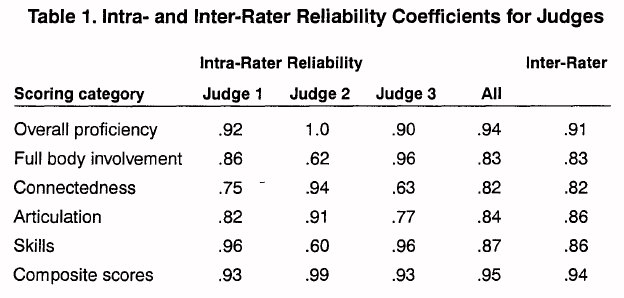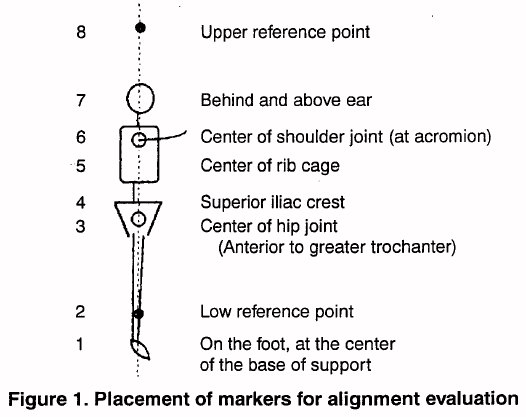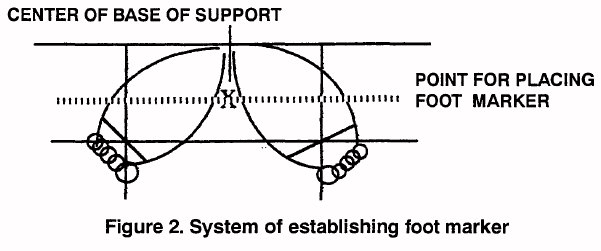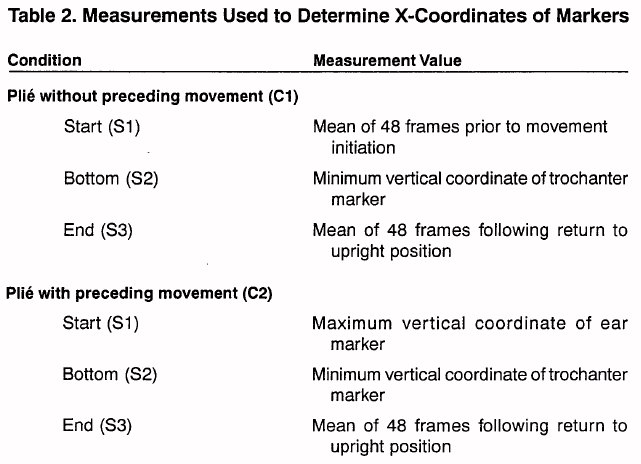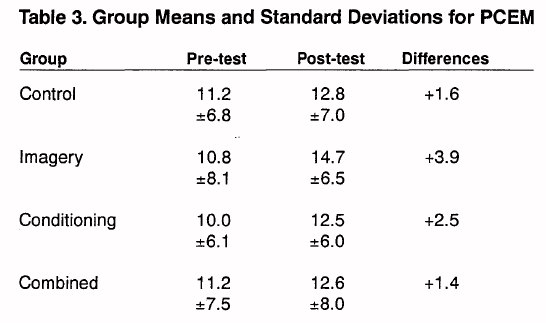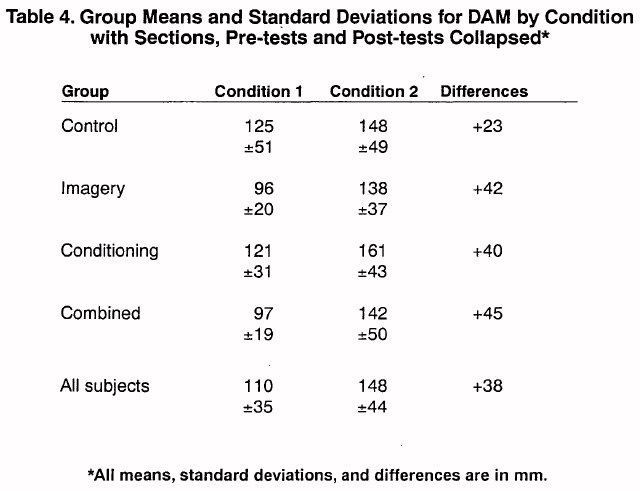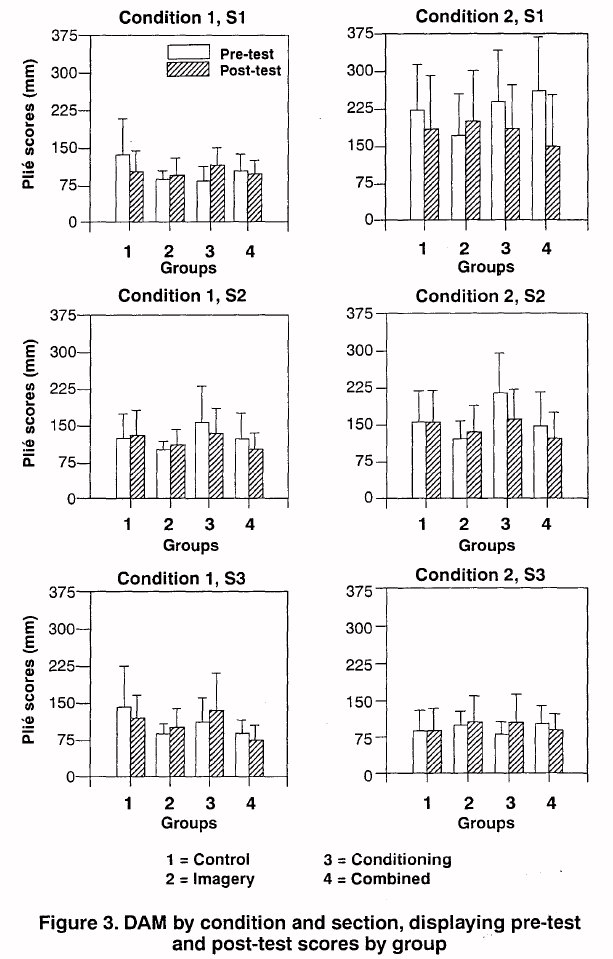
Imagery and Conditioning Practices for Dancers
Donna H. Krasnow, M.S., Steven J. Chatfield, Ph.D., Sherrie Barr, M.F.A., Jody L. Jenson, Ph.D., Janet S. Dufek, Ph.D.
Dance Research Journal, 29/1, Spring 1997.
Introduction
As western theatrical dance has developed through the centuries, dance educators, artists, and researchers have sought methods to improve dance skills and to refine the quality of dance performance. In the pursuit of ever-increasing technical skills, improved alignment, freedom from injury, and enhanced artistic capabilities such as expanded dynamic and expressive range, dancers have explored numerous training systems developed for these purposes. These systems are often used in conjunction with dance technique classes, and they explore a range of approaches addressing different aspects of the neural and motor mechanisms underlying dance skills. In general, the systems can be seen as operating within two large concerns. The first includes systems using imagery and/or mental practice designed to affect alignment and dance performance on the subcortical or neurological level, with minimal or no physical action (Bartenieff 1980; Dowd 1990; Sweigard 1974; Todd 1937). The second emphasizes consistent and specialized exercise programs designed to encourage muscular strength and endurance, flexibility, and/or cardio-respiratory endurance, with the claim that these physical changes will enhance alignment, dance technique, and performance (Clippinger-Robertson 1990; Fitt 1988; Kravitz 1990; Lauffenburger 1990; Pilates 1945; Russell 1992; Solomon 1990; Stephens 1990; Trepman, Walaszek, & Micheli, 1990). While there is often overlap in these two categories, the first group emphasizes neuromuscular re-patterning to alter alignment or movement habits, while the second addresses muscular/structural alterations to affect change. For example, the body therapies, including the work of Bartenieff, Alexander, Feldenkrais, and Sweigard, attempt to alter the way muscles pattern themselves, stressing whole body activity, connections, and awareness, not exercises for specific muscles (Myers 1980). Conditioning programs, on the other hand, do engage particular muscles, in order to make gains in muscular strength and range of motion.
Mental imagery can be defined as a psychological activity which evokes the physical characteristics of an absent object or dynamic event. Mental imagery does not necessarily involve visualizing a particular movement sequence or event. Overby (1991/1992) describes mental imagery as a method of seeing oneself in action, and it can include sensations surrounding an event. Mental practice, differentiated from mental imaging, is the covert rehearsal of a physical activity in the absence of any observable muscular movements. In dance practice, Overby (1990) has identified several types of images: (a) Visual imagery is nonverbal memory representation of visually-comprehended concrete objects or events in which such representations are actively generated and manipulated by the individual (Paivio 1971, as cited in Studd 1983). (b) Kinesthetic imagery is a nonverbal memory representation of kinesthetically-comprehended movements in which such representation is actively generated and manipulated by the individual (adapted from Paivio 1971, as cited in Studd 1983). (c) Direct imagery is a nonverbal representation of an actual movement. (d) Indirect imagery is a metaphorical image indirectly related to a specific movement (Studd 1983). This form, sometimes called metaphorical imagery, is the representation of the desired movement with a figure or likeness. (e) The terms internal and external imagery refer to the perspective. While internal imagery involves seeing and feeling from within the process, external imagery involves imagining as if viewing a video (Overby 1991/1992). Hanrahan and Salmela (1990) categorize imagery as follows: (f) Lines-of-movement imagery designates a specific direction required in the relative positions of parts of the skeletal framework. (g) Global imagery, which involves totality images, creates an overall state or feeling sense. (h) Anatomical imagery refers to images that specify muscle or joint action, and skeletal structure.
Conditioning for dance is defined by Fitt (1988) as the development of the individual's movement potential through a system of specific exercises, formulated to improve the individual's abilities. These exercises are designed to eliminate weaknesses and/or enhance strengths. In particular these exercises improve the dancer's muscular, physiological, and/or psychological ability to execute a particular style or a variety of movement styles. General categories of conditioning include muscular strength, muscular endurance, cardiovascular endurance, and flexibility.
While there is considerable literature involving the use of imagery in dance (Eddy 1992; Fortin 1993; Matt 1991/1992; Minton 1990, 1991/1992; Smith 1990), there are relatively few dance research studies which have systematically evaluated the effects of imagery on dance performance or alignment (Fairweather & Sidaway 1993; Hanrahan & Salmela 1986, 1990; Pokora 1988; Studd 1983). Substantial research has been done, however, in sport science and movement studies examining the role of imagery and mental practice in improving motor skills. There is considerable support for the hypothesis that imagery and mental practice can enhance motor performance (Denis 1985; Feltz & Landers 1983; Hall, Buckolz, & Fishburne 1989; Hall, Buckolz, & Fishburne 1992; Martens 1984). The relatively few dance research studies examining the role of imagery in improving dance performance provide results that are generally less conclusive. There is a consensus, however, that one of the major obstacles to arriving at clear results is the lack of a coherent, sophisticated method to evaluate improvements in the area of the quality of dance performance.
The ongoing development and implementation of imagery systems and conditioning programs, and their respective goals and benefits, raise the possibility of combining these systems to further enhance their efficacy. The Sport science research suggests that using both imagery and physical practice might add benefit, increasing the potential uses of such a combined program. Furthermore, the systems approach to the study of motor control suggests that it is imperative to consider both the mechanical and the neurophysiological perspectives in altering or training balance and locomotion mechanisms, and that it is the interaction of these systems that determines the efficiency of resulting patterns (Schenkman 1989; Woollacott & Shumway-Cook 1990). Certainly there is sufficient inquiry, both theoretical and experimental, to direct further research on the question of combining imagery and conditioning practices. However, in order to test the hypothesis that imagery integrated into conditioning improves dance performance and alignment, specific evaluation methods must be developed.
The purpose of this study was threefold:
1. First, to develop and test measurement tools that could be used to evaluate the effects of conditioning-with-imaging on dance performance and body alignment.
2. Second, to evaluate the influence of conditioning-with-imaging on dance performance.
3. Third, to evaluate the influence of conditioning-with-imaging on body alignment for dance.
To achieve these purposes, several steps were taken. First, a performance evaluation method was developed to measure changes and improvements in the following: (a) full body involvement in movement, (b) body integration and connectedness in movement, (c) articulation of joints and body segments, and (d) movement skills in dance material that includes direction changes, balances, and changes in level, speed and dynamic, or movement quality (See Appendix A). Second, a method of assessing vertical, central alignment during both quiet stance and movement was developed. Third, a conditioning system for dancers was designed, by integrating and synthesizing current practices of Fitt (1988), Pilates (from Friedman & Eisen 1980), Rommett (1981-1983), and Solomon (1988, 1990). Fourth, an imagery system for dancers was developed, by integrating and synthesizing the work of Bartenieff (1980), Dowd (1990), and Sweigard (1974). Finally, a system was designed which integrated imaging into conditioning practices for dancers, using the systems described above.
Methodology
The methodology for this study had four components: (a) development of the imagery system, the conditioning system, and the conditioning-with-imaging system, (b) selection and grouping of the subjects, (c) measurement protocols, and (d) analysis.
The imagery system was designed by integrating and synthesizing the work of Bartenieff (1980), Dowd (1990), and Sweigard (1974). Care was taken to incorporate images that were anatomical and metaphorical, lines-of-movement and global, visual and kinesthetic. The conditioning system was developed from the work of Fitt (1988), Pilates (from Friedman & Eisen 1980), Rommett (1981-1983), and Solomon (1988, 1990). Due to time and facility limitations, cardiovascular endurance elements were not included. The conditioning-with-imaging system combined the two, involving the subjects in moving and imaging simultaneously.
Twenty university dance students volunteered for the study. Volunteers were initially tested for imaging ability, using the 1983 Movement Imagery Questionnaire by Hall and Pongrac (used by permission of Craig R. Hall, 1993), and only those with moderate to high imaging abilities were included in the study. Volunteers also answered a questionnaire for medical screening. Nineteen of the volunteers were determined to be suitable for the study. Subjects were divided into four matched groups: (1) imaging only, (2) conditioning only, (3) conditioning-with-imaging, and (4) control. The goal of the matching was an effort to equalize the groups on performance and imaging abilities, due to small sample sizes. After the training sessions for the judges, which are described below, the judges observed and scored the videotapes of the subjects' pre-tests from the dance performance measure (PCEM), also described below. Equalization was accomplished using these initial pre-test scores and the scores from the Movement Imagery Questionnaire. Thus, each of the four groups had dancers ranging from level 1 to level 3 in dance proficiency level, based on PCEM pre-test scores, and dancers of moderate to high imaging abilities, based on the Movement Imagery Questionnaire. Then, treatments were randomly assigned to the four matched groups. Each of the three training groups met for 1 hour, 3 times per week, for 8 weeks.
All four groups were pre- and post-tested using two measures specifically developed for this study: (1) the Performance Competence Evaluation Measure (PCEM) and (2) the Dynamic Alignment Measure (DAM). The latter used kinematic equipment in the Motor Control Laboratory at the University of Oregon.
The Performance Competence Evaluation Measure (PCEM) was developed to assess aspects of dance performance, and is a modification of the Aesthetic Competence Evaluation (ACE) designed by Chatfield and Byrnes (1990). Additionally, the work of Bartenieff (1980) and an evaluation system by Parrott (1993) were used to design PCEM. Three educators from local professional dance organizations were trained as judges to evaluate the subjects in four categories reflecting specific objectives of the training: (a) full body involvement: axial, locomotor, and limb energy, that is, whether limbs remain energized even when not specifically articulating; (b) body integration and connectedness: central energy or support for movement, spine articulation and sequencing, and the overall relationship of body segments; (c) articulation of body extremities: lower limb activity and upper limb activity; and (d) movement skills: direction changes, balancing, and changes in level, speed, and dynamic, or movement quality. In addition to rating the subjects in the four categories, each subject was given an overall proficiency rating (See Appendix A).
Scoring calibration was developed during the two training sessions for the judges. Training sessions for judges involved observing and scoring pilot videotapes of dancers who were not subjects for the study. The dancers learned an extended modern dance movement sequence incorporating various styles and dynamics. In the first training session, judges discussed their individual scoring methods and suggested refinements to the dance sequence, based on objectives of the study. They also suggested developments in the wording and design of the measurement tool (See Appendix A). In the second training session, judges again viewed pilot videotapes of the volunteer dancers (non-subjects), and commented on the alterations to the dance sequence and to the Performance Competence Evaluation Measure, as well as continuing to refine their scoring methods. The judges' reliability, and in their opinion, the efficacy of PCEM, improved during the training period for the judges.
Subjects for the study used a videotaped example to learn the extended modern dance movement sequence developed by the author and refined by the judges. These subjects were then videotaped performing the sequence both pre- and post-training. Subjects completed three trials of the sequence in both pre- and post-testing. As mentioned above, judges evaluated the pre-tests before the start of the training period, to assist in placing the subjects in matched groups. After the 8 week training period and post-testing of subjects, all videos, both pre- and post-test alike, were scored again in random order to assure unbiased assessment. Also during this final session, the judges viewed and scored ten percent of the pre- and post-tests twice, randomly selected and sequenced, in order to provide companion scores for testing the intra-rater reliability of the judges. Table 1 shows the Cronbach coefficient alpha for each judge, for both individual scoring categories and the composite scores. The latter has a range of .93 to .99, indicating strong intra-rater reliability. The inter-rater reliability coefficients, seen in the last column in Table 1, range from .82 to .94. Thus PCEM also demonstrated strong inter-rater reliability. The logical validity (Safrit 1986) of PCEM was established through assessment by faculty members at the University of Oregon in the Department of Dance and by the educators who had been trained as judges for the study.
The Dynamic Alignment Measure (DAM) was developed to assess the body alignment of subjects performing a grand plié. The Peak 5 Clinical and Research Video System, a motion analysis system, was used to quantify the horizontal displacement of markers on the body from an established vertical plumb line. This kinematic equipment was selected because movement evaluation can be executed without any excess wires or bulky apparatus on the body of the subject, thereby providing a context most resembling an actual dance setting.
Data were collected with a single camera, a digital Panasonic WV CL350 color camera, equipped with a 8-48 mm Cosmicar zoom lens. To minimize camera misalignment and parallax errors, the camera was positioned as far as possible from the action, and zoomed in so that the subject filled the complete field of view. The camera was also leveled in the frontal plane to maintain an image perpendicular to the floor, and leveled in the anterior/posterior plane. Video sampling rate was 60 Hz.
Data were collected in the Motor Control Laboratory at the University of Oregon. The background was draped with a black foam material to reduce background light and increase contrast with light reflective markers placed on the subjects. Subjects were dressed in long-sleeved, black leotards and tights, and black socks. A flood light was placed just in front of the camera lens facing the subject, to further highlight the light reflective markers.
Light reflective markers were placed on specific landmark points seen in Figure 1. The two reference points, suspended on a plumb line just in front of the subject, were used to "calibrate" the space, that is, to determine that the camera was recording an image of the subject that was exactly perpendicular to the ground. Calibration was performed during each collection to determine the average error between the reference points in both the pre-tests and post-tests. For the pre-tests, the mean error was ± 2.13 mm, with a standard deviation of 1.76 mm, and a maximum difference of 9.00 mm. For the post-tests, the mean error was ± 3.68 mm, with a standard deviation of 1.26 mm, and a maximum difference of 9.00 mm.
Automatic Data Capture was used to capture and digitize the data. Ten percent of the pre-test trials were redigitized to test the reliability of the digitizing procedures. The reliability test, done on the sums of the horizontal displacements of the body markers, demonstrated a reliability coefficient of .995 (Cronbach's alpha).
The standard reference points for assessing vertical, central alignment, as discussed in kinesiology and dance literature, were used to place the reflective markers on the subjects. The use of the center of the base of support to mark the foot is suggested by Hellebrandt (1940) who observed that in every individual she studied, the average location of the center of weight during postural sway came remarkably close to the geometric center of the support base. Luttgens, Deutsch, and Hamilton (1992) re-affirm this relationship in their discussion of posture and stability. The center of the base of support was located by tracing the subject's feet in first position, turned out. A box was then drawn that included a line passing the heels, and a line intersecting the midpoints of two lines through the distal metatarsal heads, seen in Figure 2. In cases where the midpoints of the two metatarsal lines did not establish a line parallel to the heel line, due to uneven turnout, an average of the two was used.
Subjects executed the grand plié in first position, turned out, with the arms out to the side in second position. (In this arm position, the markers placed on the body were not blocked from the video camera's view.) Six trials were done during each test period. The first three trials were self-paced and done with no distraction (Condition 1). The next three trials were done with music playing and following an extreme range-of-motion, off-center torso movement, in order to record how the subject's alignment was altered in a situation similar to an actual dance environment. This condition (Condition 2) tested the transfer effect of the training systems from a simple context to a complex sequence involving serial movement and multiple body areas. The subject was required to do a common modern dance torso movement set to music, that started with an arch, and rolled through side bend to a forward curve (with a demi-plié), and back up to vertical (with legs straightening, and arms lifting to second position). From this vertical moment, with no pause, the subject then initiated the grand plié, and continued the movement to completion at stance. Thus, the subject was required to establish vertical, central alignment, not in quiet stance but as a reference point out of an off-center movement directly into the plié.
For each of the six trials, the subjects received three scores, one for each of three sections (S1, S2, S3) of the plié: start of the plié, bottom of the plié, and end of the plié. The scores were determined in the following way: To quantify the horizontal displacement of the markers in relation to the plumb line, the absolute value of differences in X-coordinates between marker 1 and the markers 3-7 on the body were calculated and added. (Markers 2 and 8, the reference points, used to calibrate the camera system, and to ensure that a true perpendicular line was established, were not included in these calculations.) Thus, for Condition 1, Trial 1, Section 1, the score C1T1S1 would be the sum of absolute values of horizontal displacements of the markers: | m3 - m1 | + | m4 - m1 | + | m5 - m1 | + | m6 - m1 | + | m7 - m1 |, where the raw data collected were: foot marker, m1; trochanter marker, m3; iliac marker m4; rib marker, m5; acromion marker, m6; and ear marker, m7. Table 2 summarizes the system for determining the X-coordinate measurements.
In handling the data, there were initially 18 pre-test scores and 18 post-test scores for each subject, one for each of three sections of the plié, for each of the three trials, for two conditions. A mean of the scores for the three trials was then computed, resulting in a single score for each section of the plié, for each condition (C1S1, C1S2, C1S3, C2S1, C2S2, and C2S3). For example, to compute the score for Condition 1, Section 1: C1S1 = (C1T1S1 + C1T2S1 + C1T3S1) / 3. Thus, each subject had six pre-test scores and six post-test scores.
The analyses of data were performed separately on PCEM and DAM. The analysis for PCEM consisted of a two-factor analysis of variance (ANOVA); the design was a 4 X 2 (group by time, with repeated measures on the second factor) mixed, within-subjects design, with subjects nested in the pre-test and post-test repeated measures. The analysis for DAM consisted of a three-factor analysis of variance (ANOVA); the design was a 4 X (2 X 2) (group by time by condition, with repeated measures on time and condition) mixed, within-subjects design, with subjects nested in the pre-test and post-test repeated measures. Alpha was set at .05 for all analyses.
Results
Performance Competence Evaluation Measure
The analysis of variance performed on PCEM composite scores showed significant results for the main effect of time, F(1, 15) = 21.67, p = .0003, with scores increasing from pre- to post-testing. There were no significant results for the main effect of group, or for the time by group interaction. All subjects, with the exception of two, demonstrated increases in composite scores. Table 3 displays the means and standard deviations for the four groups, in both pre-tests and post-tests.
Dynamic Alignment Measure
DAM scores for each subject were determined by adding the horizontal displacements of the body markers from the vertical plumb line passing through the foot marker. (Lower scores indicated an alignment with body segments closer to the plumb line.) Score means for the three trials for each condition were calculated, resulting in each subject having 12 scores: one for each of the three sections, for each of the two conditions, for both pre-test and post-test.
The analysis of variance performed on DAM indicated that Condition 2 scores were significantly greater than Condition 1 scores (F(1, 15) = 10.296, p = .0032). For all subjects as a pool, the mean score for Condition 2 was 38 mm greater than the mean score for Condition 1. There were no significant results for the main effects of group and time, and there were no significant interactions. Table 4 displays the means and standard deviations for the four groups in the two conditions, with sections, pre-tests and post-tests collapsed. All groups showed increased scores in Condition 2, indicating an alignment with body segments farther from the plumb line.
Discussion
The study tested the primary hypothesis that conditioning-with-imaging would result in improved body alignment, and in advancements in dance performance. The study tested the secondary hypothesis that improvements caused by conditioning-with-imaging would be significantly greater than gains made by conditioning only or imaging only. Discussion of the two measures, PCEM and DAM, will be done separately, and then recommendations will be discussed, and the interrelationship of the PCEM and DAM results will be evaluated.
Performance Competence Evaluation Measure
The development of PCEM as a measure of changes in dance performance was a major step in undertaking this study. To date, few measures have been designed for dance research which attempt to quantify and score various aspects of dance performance, such as full body involvement in movement, body integration and connectedness, articulation of joints and body segments, and movement skills. Further, this is the only known measure developed for dance performance which has tested so high in intra- and inter-rater reliability, and as such, may function as an important tool for future dance studies.
Results indicated that the subjects in this study showed significant increases in PCEM scores over time. It can be seen from Table 3 that all four groups, including the controls, increased in mean composite scores in PCEM. There were no significant results for the main effect of group, or the time by group interaction. Thus, these data do not support discussion of differences between groups based on training effects of this study. The judges viewed the pre-test and post-test trials, and the various subjects, in randomized order, and were not informed about whether they were viewing a pre-test or post-test trial, thereby preventing bias in the scoring process. Accepting the logical validity and the tested levels of reliability of PCEM, it can be assumed that these changes in scores accurately reflect changes in the subjects themselves. There are intervening variables which could account for these results.
It should be noted that the subjects were first tested at the start of winter quarter, and many had not been actively involved in dancing for 3 to 4 weeks prior to testing, due to term break. Thus, increases in scores could be expected from the 8 weeks of daily dance classes and rehearsals during the winter quarter. These typical increases may have masked any increases due to the study's training systems, above the baseline of activity. Similarly, there is no way to determine if there was a learning effect from repeated testing. Although there were 8 weeks between testing periods, subjects commented about the ease of learning the phrase the second time. Perhaps a longer time period for training, even as much as six months, would allow for more time between pre-test and post-test sessions, thereby diminishing the ease of recall.
While it was required that all subjects, including controls, be enrolled in University of Oregon dance technique classes at a low intermediate to advanced level, it was not possible to control for varying levels of activity. Some of the subjects took the minimum of 3 classes per week, while others were taking 11-14 classes per week, plus several hours of rehearsals. It is impossible to ascertain how differing amounts of dance classes and rehearsals affected the subject's PCEM scores. The imbalances in activity levels may have contributed further to masking any effects of the training systems.
There is also the question of emotional effects on dance performance. The end of term for university students is a highly charged time period, with extreme stresses of finals and grades. Additionally, some students were receiving very positive information about their progress during the term, while others were receiving negative feedback. End-of-term performances further heighten possible stress and emotional fluctuation, both positive and negative, during this time period. There is no way to determine how these emotional issues altered the PCEM results.It is suggested that a psychological evaluation, such as a standardized stress test, be administered to subjects both pre- and post-testing.
The development of PCEM was an important step in undertaking this study. The logical validity and the tested reliability of the measure suggest that increases in PCEM scores represent actual improvements in the dance performance of the subjects, including improvements due to dance activities as well as test/retest learning. Thus, the use of PCEM depicted significant improvements for all subjects pooled in only a 10 week period of dancing, suggesting that PCEM may be highly sensitive as a measurement tool. Additional validity tests, such as a known group differences test (Safrit 1986), are recommended, involving blind judges (that is, judges who are unfamiliar with the dancers being rated) using PCEM to rate groups of dancers from a wide span of levels and classes, from beginners to dance professionals. This validity testing would further substantiate the development and use of PCEM or its adaptation in future dance studies, and its value in the assessment of dance performance.
Dynamic Alignment Measure
This study presents the first data from dance research collected on subjects during dance movement, and analyzed with respect to changes in alignment. Traditionally, subjects have been measured for alignment studies primarily during quiet stance. The results from this study suggest that studying alignment in quiet stance may yield results that are inapplicable to actual conditions relevant to dance practice, i.e., making continuous dynamic adaptations to alignment as the body reacts to changes in balance and equilibrium.
Results for DAM scores indicated that Condition 2 scores were significantly greater than Condition 1 scores for all subjects (See Table 4). However, there were no significant results for the main effects of group and time, or for any interactions. Thus, these data do not support discussion of differences between groups based on training effects of this study.
In a descriptive sense, the difference between the two conditions concerned what preceded the plié. In Condition 1, the subject started the plié from quiet stance, whereas in Condition 2 the plié began after a dynamic, off-center movement. This is a crucial issue in the development of dance science research, since dancers are usually in motion and locomoting, whereas research about vertical, central alignment has been done primarily in static conditions (Fairweather & Sidaway 1993; Kerr, Krasnow, & Mainwaring 1992; Sweigard 1974). Therefore, it was important to investigate precisely where during the plié the subjects varied during the two conditions. In other words, how did the preceding movement or stillness alter the execution of the plié? To examine this question, it was necessary to break the conditions down into the three sections of the plié. (Recall that Section 1 is the start of the plié, Section 2 is the bottom of the plié, and Section 3 is the finish of the plié or return to stance.) Further, since the main focus of this study was the training effects, it was decided to retain distinct testing scores and the uniqueness of the four groups. This allowed a closer examination of how each of the groups performed during specific sections of the plié, both prior to and after training. After calculating the pre- and post-test group means for each section for both conditions, these means were displayed graphically. (See Figure 3.)
It can be seen from the histograms displayed in Figure 3 that vertical, central alignment is highly variable. The lowest group means (indicating best performance) occurred in C1S1 (Condition 1, Section 1), C1S3, and C2S3, which were moments of quiet stance at the beginning and end of the plié. Further, it was C2S1 that demonstrated the largest upward fluctuation in group means (indicating worst performance) and contributed to the significant difference between the two conditions. This section of Condition 2 is the moment of return to vertical from the most extreme off-center torso movement, a movement typical in the modern dance movement vocabulary. If it is the case that vertical, central alignment as a transition during movement varies notably from vertical, central alignment in quiet stance, as this study indicates, then it is possible that dancers are capable of learning the skill of aligning the body in quiet stance, without the ability to transfer this skill to complex movement phrases that integrate vertical, central alignment. Since it has been common practice in dance research to assess vertical, central alignment in quiet stance only, the issue of transferring improved vertical alignment to movement has not been addressed. In this study, vertical, central alignment was assessed in two conditions, one in quiet stance, the second, as a transitional moment in the context of dance movement. Condition 2 scores were significantly higher than those for Condition 1, meaning that alignment was far more variable in the dynamic condition. This suggests implications for future dance studies. Research regarding alignment may need to focus on dynamic rather than static measures, if applied settings and transference from training to performing are important to the studies.
Examining Figure 3 further, it is clear that the greatest variance between conditions was in Section 1, the start of the plié, displayed in the upper right-hand corner. Means for all four groups were higher in C2S1 than for any of the other five sections, which suggested a further analysis of this condition and section. A 4 X 2 analysis of variance (group by time, with repeated measures on the second factor) mixed, within-subjects design, with subjects nested in the pre-test and post-test repeated measures, was performed on data for C2S1.
Across all subjects combined, the C2S1 scores were significantly lower for post-tests than for pre-tests, F(1, 15) = 8.89, p = .0093, with the post-test mean for all subjects pooled being 39 mm lower than the pre-test mean. There were no significant results for the main effect of group. There was, however, a significant interaction between time and group, F(3, 15) = 3.64, p = .0373.
Upon closer examination, there are two salient features of the graph in the upper right-hand corner of Figure 3 that could explain this interaction: 1) Group 2 changed in a direction opposite to the other three groups. (Group 2, the imagers, had worse post-test scores, while all other groups had better post-test scores.) 2) Group 4, the conditioning-with-imaging group, showed a much larger post-test improvement than all other groups. Both the control and the conditioning groups decreased in score means between pre-test and post-tests moderately, indicating what is considered to be improved alignment in the context of this measure. (As horizontal displacement of the body markers decreases, the body segments line up in a more vertical arrangement with respect to the anatomical plumb line.) The post-test mean score for the control group was 37 mm less than the pre-test, and for the conditioning group, it was 51 mm less. The conditioning-with-imaging, or combined, group decreased in mean scores between testing periods by 111 mm, two to three times the decrease of the other two groups. On the other hand, the imaging group had an increase in group mean scores, of 26 mm. It is this reversal of direction by group 2, along with the large improvement by group 4, that accounts for the significant time by group interaction. These results have important implications for the transference of training systems to dance practice, and for the potential value of integrating both conditioning and imagery work into dance training methods.
While no other comments can be made based on statistical significance, it is of interest to examine the results of the various training systems across all sections of both conditions. Observing Figure 3, the imagery group increased in mean scores between pre-testing and post-testing for all three sections of both conditions, indicating larger deviations in alignment from the plumb line. The subjective comments of these subjects may offer some insight into these results. In general, the subjects from the imagery group felt that they had improved over the training period. In particular, they subjectively experienced improvements in alignment during the training sessions, but they did not feel that they could sustain these changes when they moved into the dance class or rehearsal context. They commented that while doing complex movement, it was not possible to concentrate on the imagery needed to sustain the changes in alignment they experienced during the sessions. It could be that 8 weeks is too short a time period for mastery of changes caused by imagery, which are allegedly on the neural level, to transfer to complex movement. It also presents the possibility that changes caused by imagery and visualization do not transfer to complex movement without intervening training that slowly introduces the images into a simple movement context.
Conversely, the combined group (conditioning-with-imaging) decreased in mean scores between pre-testing and post-testing for all three sections of both conditions, indicating smaller deviations in alignment from the plumb line. They were, in fact, the only group to have decreased mean scores in Sections 1-3 for both Condition 1 and Condition 2. This result for the combined training of conditioning with imagery is encouraging, and certainly supports pursuing further research into this type of training for dancers.
Recommendations
PCEM needs further development and further assessment of its validity, but this study indicates that it is a reliable tool for measuring certain aspects of dance performance, including full body involvement in movement, body integration and connectedness in movement, articulation of joints and body segments, and movement skills in dance. The training sessions with the judges prior to evaluation of test subjects were crucial to the strong intra- and inter-rater reliability coefficients, ranging from .93 to .99 for composite scores. Training sessions for the judges are recommended for future use of PCEM and similar measures.
It is recommended that testing periods avoid high stress times, such as the end of term for student dancers. Emotional fluctuation is large, and it is difficult to determine the effects of these emotional states on test results. Additionally, it is recommended that a standardized psychological stress test be administered to subjects both pre- and post-testing.
The results also suggest changes in the design of the study. To increase the power of group analyses, a larger sample size would be beneficial. It also seems advisable to have a sample with a more consistent level of activity, that is, a similar number and type of classes and rehearsals each week. As most dance researchers realize, this is a nearly impossible condition to fulfill, especially if one is intending to include large numbers of dancers in a study. Nevertheless, studies involving small samples with highly varied activities are problematic for group analysis.
If highly variable responses within subjects or differential responses between subjects are more the rule than the exception, as data from this study suggest, single subject or within subject designs and analyses could yield more usable information. What within subjects designs would sacrifice in external validity, they would make up for through enhanced internal validity. Within subjects designs would preserve the uniqueness of each participant instead of averaging an individual's data into a larger group. If dancers are responding differently to training, individual differences among members of groups could cancel each other out and actually hide training changes through group averaging. By contrast, analysis of an individual's response might reveal that, although different from another's response, it nonetheless reflects a change attributable to training. To increase the statistical power of within subject's analyses, the number of repeated measures, e.g. trials or testing sessions, acquired for each subject can be increased in much the same way that increasing numbers of group members can increase statistical power for group analysis. In this way, the repeated measure for each subject operates to form the "group" of data that is averaged and compared to evaluate pre-training to post-training changes. When differential responses among group members are found, within subject analysis is actually mandated. Within subjects designs are often the preferred designs when a large investment is made in training. Payton (1988) offers an easily understandable introduction to some of these designs. For more advanced treatments, one can refer to Barlow and Hersen (1984); Bates, Dufek, and Davis (1992); and Keppel (1991).
Further, it is suggested that the training sessions extend over longer time periods, particularly when addressing neural components of alignment and movement. While positive effects may occur during static situations, there are questions about transfer of training to more dynamic events. Similarly, the evidence in the study from DAM scores suggests that it is imperative to conduct more research on dancers during active movement. This study indicates that deviations in vertical, central alignment are highly variable across movement conditions. While examining alignment in quiet stance may provide some useful insights, it is also crucial that researchers explore methods of analyzing alignment while the body is in motion, and ideally, in movement that closely simulates the dancer's activities in class, rehearsal, and performance.
The results of this study indicated significant increases in PCEM scores, independent of changes in DAM scores. Accepting the given levels of validity and reliability for the two measures, the evidence suggests that dance performance can improve without an accompanying improvement in vertical, central alignment. There is still the question of whether improvements in alignment cause improvements in dance performance, that is, whether significant changes in DAM scores would have caused significant changes in PCEM scores. Since there were no significant changes in DAM scores overall, this study cannot address this question. Additionally, there are other theoretical benefits to improvements in alignment, such as injury prevention and dance career longevity, that could possibly be tested using measurement tools developed in this study. Finally, the conditioning-with-imaging group showed a much larger post-test improvement in DAM scores than all other groups, at the moment in testing when the subject returned to vertical, central alignment following complex movement sequencing. This result suggests that conditioning-with-imaging may be addressing the issue of transference of improved alignment from stance to actual dance conditions. Further research into systems that combine conditioning work with visualization work is recommended.
In the larger picture, it is important that researchers continue to develop quantitative measures (such as DAM) along with dance performance measures (such as PCEM), in order to assess and validate the usefulness of training systems for dancers. Moreover, research questions need to address a variety of potential influences on dance training. For example, do changes in muscular strength and flexibility affect dance performance? How do imagery systems in the absence or presence of movement influence various aspects of dance performance? Future research in dance depends on the development and the implementation of valid and reliable measures, both quantitative and qualitative, in order to address the broad spectrum of training and performance issues.
APPENDIX A PERFORMANCE COMPETENCE EVALUATION MEASURE
Table A-1
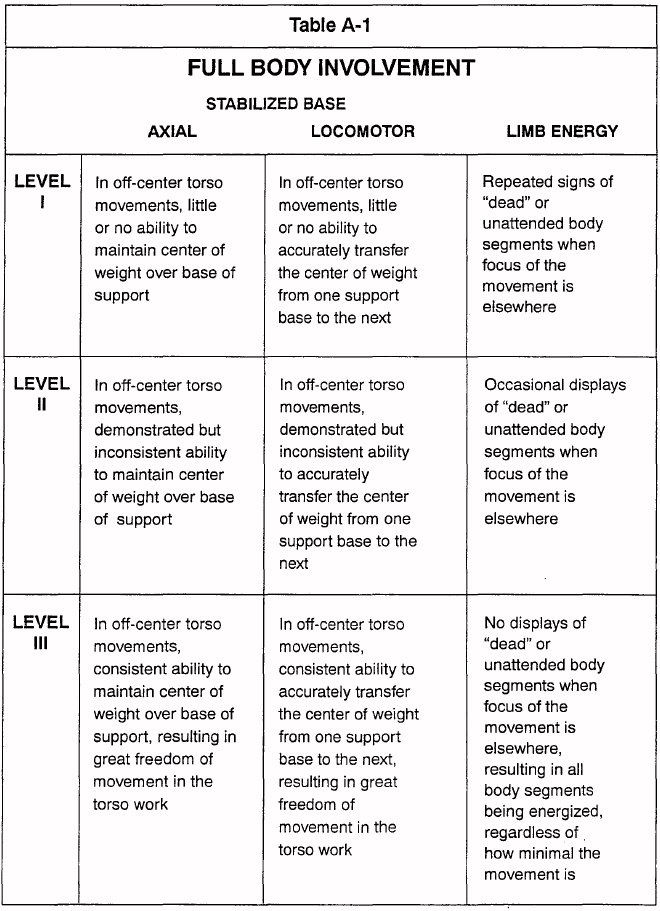
Table A-2
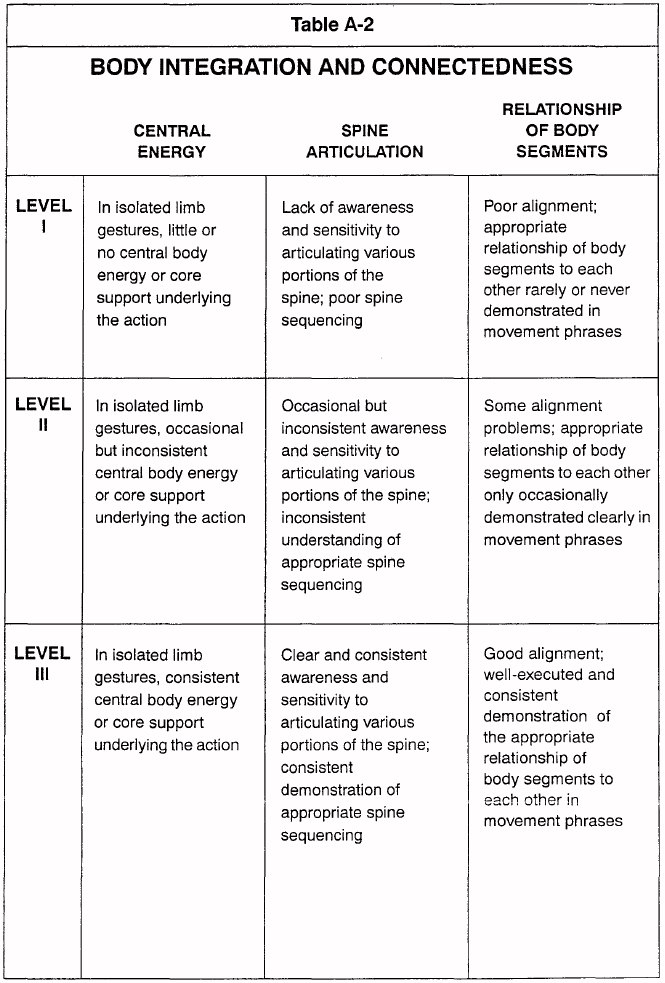
Table A-3
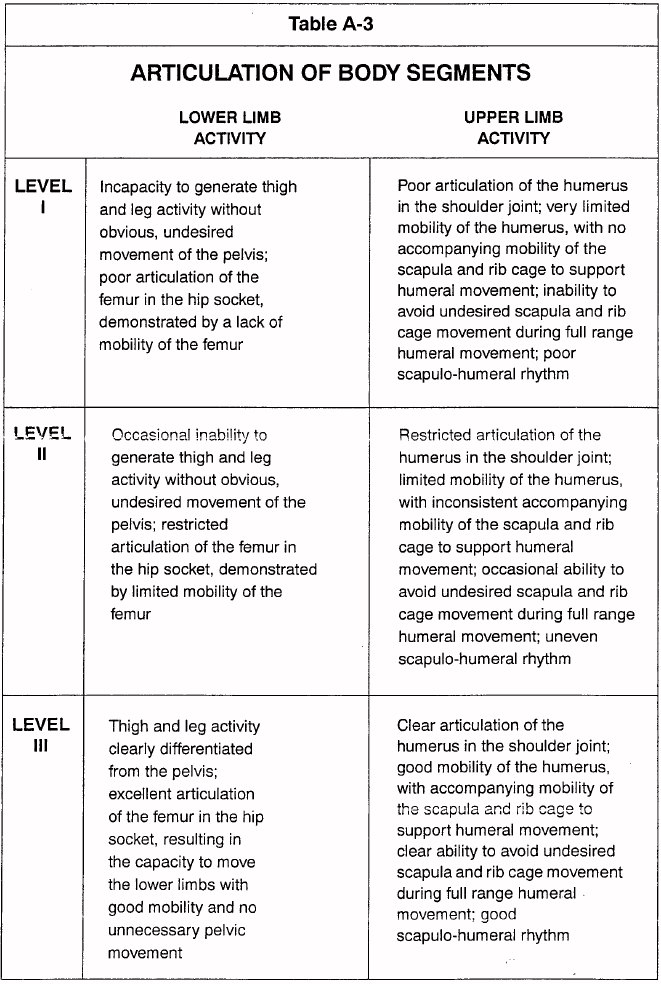
Table A-4
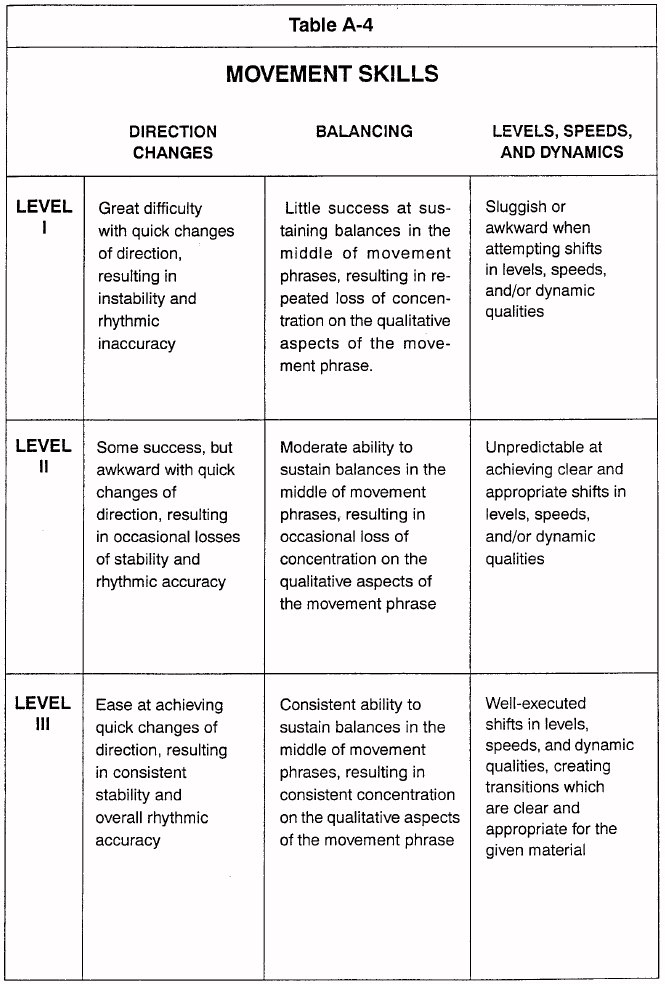
GUIDE AND SCORE SHEET FOR JUDGES
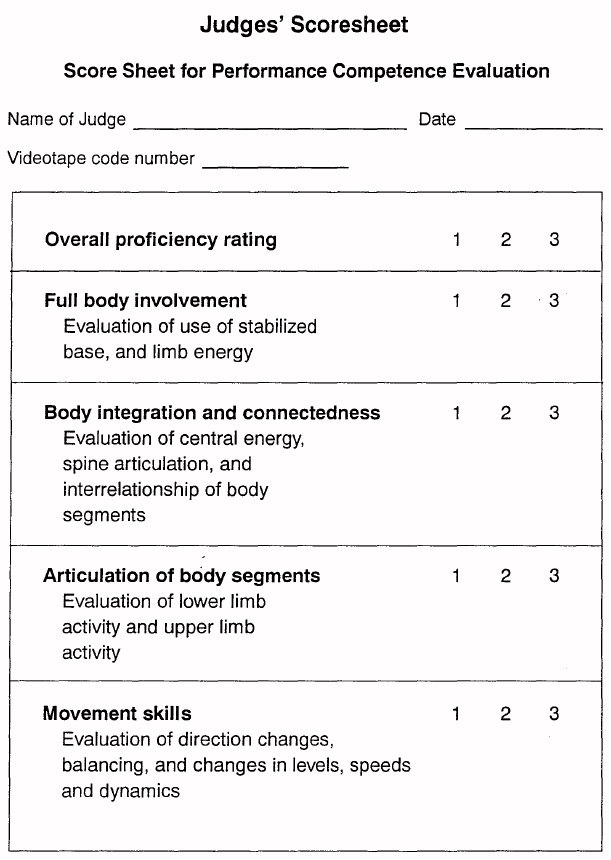
REFERENCES
Barlow, D. H., & Hersen, M. 1984. Single case experimental designs (2nd ed.). New York: Pergamon Press.
Bartenieff, I., with Lewis, D. 1980. Body movement: Coping with the environment. New York: Gordon and Breach, Science Publishers.
Bates, B. T., Dufek, J. S., & Davis, H. P. 1992. The effect of trial size on statistical power. Medicine and Science in Sports and Exercise, 24(9), 1059-1065.
Chatfield, S. J., & Byrnes, W. C. 1990. Correlational analysis of aesthetic competency, skill acquisition and physiologic capabilities of modern dancers. In 5th Hong Kong International Dance Conference Papers (pp. 79-100). Hong Kong: The Secretariat of the Hong Kong Academy for the Performing Arts.
Clippinger-Robertson, K. 1990. Biomechanical considerations in turnout. In R. Solomon, S. Minton, & J. Solomon (Eds.), Preventing dance injuries: An interdisciplinary perspective (pp. 75-102). Reston, VA: American Alliance for Health, Physical Education, Recreation, and Dance.
Denis, M. 1985. Visual imagery and the use of mental practice in the development of motor skills. Canadian Journal of Applied Sport Sciences, 10(4), 4S-15S.
Dowd, I. 1990. Taking root to fly (2nd ed.). North Hampton, MA: Contact Collaborations.
Eddy, M. 1992. Body-mind dancing. In S. Loman & R. Brandt (Eds.), The body mind connection in Human Movement Analysis (pp. 203-227). Keene, NH: Antioch New England Graduate School.
Fairweather, M. M., & Sidaway, B. 1993. Ideokinetic imagery as a postural development technique. Research Quarterly for Exercise and Sport, 64(4), 385-392.
Feltz, D. L., & Landers, D. M. 1983. The effects of mental practice on motor skill learning and performance: A meta-analysis. Journal of Sport Psychology, 5, 25-27.
Fitt, S. S. 1988. Dance kinesiology. New York: Schirmer Books.
Fortin, S. 1993. When dance science and somatics enter the dance technique class. Kinesiology and Medicine for Dance, 15(2), 88-107.
Friedman, P., & Eisen, G. 1980. The Pilates method of physical and mental conditioning. Garden City, New York: Doubleday and Company.
Hall, C., Buckolz, E., & Fishburne, C. 1992. Imagery and the acquisition of motor skills. Canadian Journal of Applied Sport Sciences, 17(1), 19-27.
Hall, C., Buckolz, E., & Fishburne, C. 1989. Searching for a relationship between imagery ability and memory of movements. Journal of Human Movement Studies, 17, 89-100.
Hanrahan, C., & Salmela, J. H. 1986. Mental imagery as a facilitator in dance movement skills. In L. E. Unestaehl (Ed.), Contemporary Sport Psychology: Proceedings from the VI World Congress in Sport Psychology (pp. 131-141). Orebro, Sweden: VEJE Publishing.
Hanrahan, C., & Salmela, J. H. 1990. Dance images--do they really work or are we just imagining things? Journal of Physical Education, Recreation and Dance, 61(2), 18-21.
Hellebrandt, F. A. 1940. Physiology and the physical educator. The Research Quarterly of the American Association for Health, Physical Education, and Recreation, XI(3), 12-29.
Keppel, G. 1991. Design and analysis: A researcher's handbook (3rd ed.). Englewood Cliffs, New Jersey: Prentice Hall.
Kerr, G., Krasnow, D., & Mainwaring, L. 1992. The nature of dance injuries. Medical Problems of Performing Artists, 7, 25-29.
Kravitz, S. R. 1990. Pronation as a predisposing factor in overuse injuries. In R. Solomon, S. Minton, & J. Solomon (Eds.), Preventing dance injuries: An interdisciplinary perspective (pp. 15-20). Reston, VA: American Alliance for Health, Physical Education, Recreation, and Dance.
Lauffenburger, S. K. 1990. Bartenieff Fundamentals: Early detection of potential dance injuries. In R. Solomon, S. Minton, & J. Solomon (Eds.), Preventing dance injuries: An interdisciplinary perspective (pp. 177-190). Reston, VA: American Alliance for Health, Physical Education, Recreation, and Dance.
Luttgens, K., Deutsch, H., & Hamilton, N. 1992. The standing posture. Kinesiology: Scientific basis of human motion (pp. 466-481). Dubuque, IA: Brown & Benchmark.
Martens, R. 1984. Imagery in sport. In Howell, M. L., & Parker, A. W. (Eds.), Proceedings of the VII Commonwealth and International Conference on Sport, Physical Education, Recreation and Dance, 8(pp. 213-230). St. Lucia, Brisbane, Australia: Department of Human Movement Studies, University of Queensland.
Matt, P. H. 1991/1992. Ideokinesis: Integrating the science and somatics of dance. Kinesiology and Medicine for Dance, 14(1), 68-77.
Minton, S. 1990. Enhancement of alignment through imagery. Journal of Physical Education, Recreation and Dance, 61(2), 28-29.
Minton, S. 1991/1992. Exploring the mind/body connection with imagery. Kinesiology and Medicine for Dance, 14(1), 29-32.
Myers, M. 1980, February-July. Body therapies and the modern dancer: The "new science" in dance training (Alexander, Bartenieff, Feldenkrais, Sweigard). Dance Magazine. [Six articles]
Overby, L. Y. 1991/1992. Principles of motor learning applied to the teaching of dance technique. Kinesiology and Medicine for Dance, 14(1), 113-118.
Overby, L. Y. 1990. The use of imagery by dance teachers--development and implementation of two research instruments. Journal of Physical Education, Recreation and Dance, 61(2), 24-27.
Parrott, A. A. 1993. The effects of Pilates technique and aerobic conditioning on dancers' technique and aesthetic. Kinesiology and Medicine for Dance, 15(2), 45-64.
Payton, O. D. 1988. Research: The validation of clinical practice (2nd ed.). Philadelphia: F. A. Davis.
Pilates, J. H. 1945. Return to life through controlology. Boston: The Christopher Publishing House.
Pokora, S. L. 1988. An investigation of imaging as a facilitator for the development of the dancer. Masters Abstracts International, 27/03, 318. (University Microfilms International No. 13-35842)
Rommett, Z. 1981-1983. Personal communication and classroom instruction from Ernest Pagano, dancer and teacher, in the Rommett floor barre work, New York.
Russell, B. 1992. Proprioceptive rehabilitation in dancers' injuries. Kinesiology and Medicine for Dance, 14(2), 27-38.
Safrit, M. J. 1986. Introduction to measurement in physical education and exercise science. St. Louis: Mosby College Publishing.
Schenkman, M. 1989. Interrelationship of neurological and mechanical factors in balance control. In P. W. Duncan (Ed.), Balance: Proceedings of the APTA Forum (pp. 29-41). Nashville, TN: American Physical Therapy Association.
Smith, K. L. 1990. Dance and imagery--the link between movement and imagination. Journal of Physical Education, Recreation and Dance, 61(2), 17.
Solomon, R. (1988). Anatomy as a master image in training dancers [Video- recording]. Santa Cruz, CA: Ruth Solomon.
Solomon, R. 1990. In search of more efficient dance training. In R. Solomon, S. Minton, & J. Solomon (Eds.), Preventing dance injuries: An interdisciplinary perspective (pp. 191-222). Reston, VA: American Alliance for Health, Physical Education, Recreation, and Dance.
Stephens, R. E. 1990. The neuroanatomical and biomechanical basis of flexibility exercises in dance. In R. Solomon, S. Minton, & J. Solomon (Eds.), Preventing dance injuries: An interdisciplinary perspective (pp. 271-292). Reston, VA: American Alliance for Health, Physical Education, Recreation, and Dance.
Studd, K. A. 1983). Ideokinesis, mental rehearsal and relaxation applied to dance technique (Master's thesis, University of Oregon, 1983). (Microform Publications: University of Oregon No. UO-85 61--UO -85 62)
Sweigard, L. E. 1974. Human movement potential: Its ideokinetic facilitation. Lanham, MD: University Press of America.
Todd, M. E. 1937. The thinking body: A study of balancing forces of dynamic man. New York: Paul B. Hoeber, Medical Book Department of Harper & Brothers.
Trepman, E., Walaszek, A., & Micheli, L. J. 1990. Spinal problems in the dancer. In R. Solomon, S. Minton, & J. Solomon (Eds.), Preventing dance injuries: An interdisciplinary perspective (pp. 103-131). Reston, VA: American Alliance for Health, Physical Education, Recreation, and Dance.
Woollacott, M. H., & Shumway-Cook, A. 1990. Changes in posture control across the life span--a systems approach. Physical Therapy: Journal of the American Physical Therapy Association, 70(12), 799-807.
